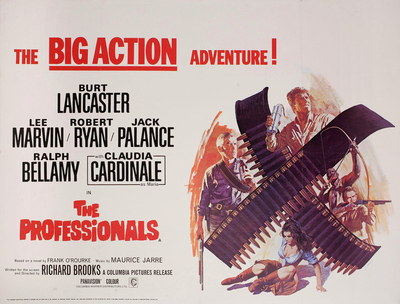The Thirty Years War was one of the most destructive conflicts in European history. Very few people died on the battlefield, but millions died by starvation and disease, most of them when a new wave of bubonic plague was carried across borders by soldiers; some parts of Germany lost up to half of their population.
But there aren't a lot of movies about the conflict: the only one I can think of is The Last Valley, a 1971 film directed by novelist James Clavell, starring Michael Caine as the ruthless leader of a group of mercenaries looking for shelter from the winter and the Plague in a hidden valley in the Bavarian mountains. It's a bleak, nihilistic picture that bases its story on one of the abiding historical conceits of the Thirty Years War – that much of its destruction came at the hands of mercenary armies, foraging or pillaging or left to their own devices between employers.
The Professionals, a 1966 western written and directed by Richard Brooks, is part of a small group of pictures about groups of gunmen, which includes much more famous titles like The Magnificent Seven (1960), The Wild Bunch (1969) and Butch Cassidy and the Sundance Kid (1969). All these films involve teams of gunfighters – outlaws, lawmen and men living somewhere in between – banding together for a job; you could even consider these pictures part of an even larger trend that includes war films (Kelly's Heroes, Von Ryan's Express, Guns of Navarone, Where Eagles Dare) and heist pictures (Ocean's Eleven, The Italian Job, The Sting).
Where these westerns put me in mind of The Thirty Years War is their setting – towns trying to rid themselves of harassment by bandits or outlaws, often at a time well after the frontier has been closed, when territories are becoming states, and men who've made a living by violence are being pushed out by the prerogatives of civilization. Agents of civilization – shopkeepers and businessmen - are willing to hire one group of gunmen to rid themselves of another, less controllable group.
Like Mitteleuropa during the Thirty Years War, the problem is too many men skilled in violence, good for little else, left over from a time when those skills were needed, now standing in the way of peace and prosperity (in which, it's assumed, they'll have no part to play.)
Like The Wild Bunch and Butch Cassidy, The Professionals begins in the first half of the 20th century: Brooks' film is actually set in the late stages of the Mexican Revolution, an ugly conflict utterly overshadowed by the First World War at the same time. Machine guns have joined the arsenals of both armies and rebels, and we even see automobiles parked next to steam trains.
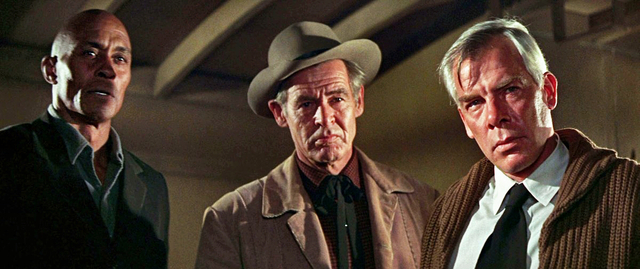
Brooks economically introduces the main characters while the credits roll: there's Rico, the weapons expert and tactician (Lee Marvin), a veteran of the Philippines and Teddy Roosevelt's Rough Riders; Ehrengard the skilled horseman and wrangler (Robert Ryan); Jake the ace tracker (Woody Strode) and Dolworth (Burt Lancaster), whose signature talent seems to be sleeping with married women until Rico explains a little later that he's an explosives expert.
They're brought together by Mr. Grant, a railway tycoon played by Ralph Bellamy, who we first see headquartered on one of his own trains, much like Gabriele Ferzetti's Mr. Morton in Once Upon a Time in the West. He wants them to cross the border into Mexico and rescue his wife, Maria (Claudia Cardinale), who has been kidnapped for ransom by a bandit and onetime revolutionary named Raza (Jack Palance).
What made Rico the obvious leader of the group was his history: not too many years previous, both he and Dolworth had used up the last of their idealism fighting alongside Raza in Pancho Villa's army. They know the territory and the enemy, and with the promise of $10,000 when they bring Maria back, the group heads across the border from Texas into Mexico – in the film little more than a wooden train trestle over a dry gulley.
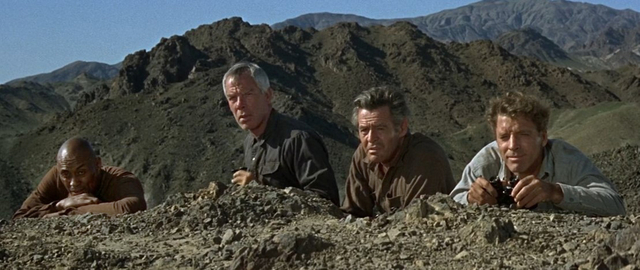
While not quite a revisionist western, The Professionals does show the influence of Italian films by Sergio Leone and others with ramped up, explicit violence that wouldn't have been seen in a Hollywood western even a few years' previous – like the cold-blooded massacre and lynching of federales by Raza and his men. But it was made well into the era when the western genre had gone into eclipse, and so Brooks understood that some updates were needed.
There are feints at sexuality and language that would never have survived the Production Code, like Lancaster's Dolworth asking his friend Rico if he'd ever noticed that "human beings are the only animals that make love face to face." Chiquita – a soldier in Raza's army played by the statuesque Marie Gomez, and a former girlfriend of Dolworth's – is seen topless (from behind) washing herself in the middle of Raza's fortified hacienda. Later, during a final showdown between the bandits and Dolworth, Lancaster calls out, asking her "How's your love life?"
The Professionals is the sort of picture with a tiny cast of stars playing characters who actually have a name, amidst a screen filled with extras and nameless henchmen. The four men – later joined by Cardinale – are the story more than the basic plot, and the film succeeds mostly how they fill out their characters and relate to each other.
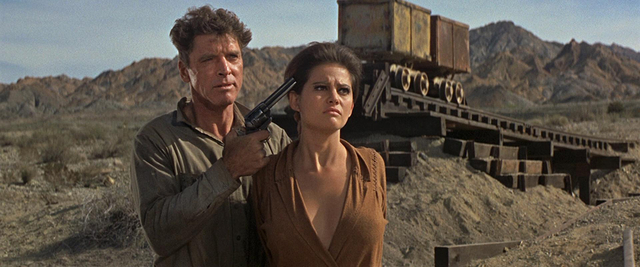
Brooks began his career as a writer; his novel The Brick Foxhole was adapted into the Edward Dmytryk noir classic Crossfire (1947), which co-starred Robert Ryan. He began writing screenplays for producer Mark Hellinger, and two of his earliest pictures, The Killers (1946) and Brute Force (1947), made a star out of a young Burt Lancaster.
Success as a writer led to offers to direct, and he spent much of the '50s working for the major studios, making films like Deadline – U.S.A. (1952), Blackboard Jungle (1955) and Cat on a Hot Tin Roof (1958). He became an independent writer/director/producer by the start of the '60s, making another adaptation of a Tennessee Williams play with Sweet Bird of Youth (1962) before a major flop – a screen version of Joseph Conrad's Lord Jim (1965), starring Peter O'Toole, with Brooks trying to recreate the epic cinematic scope of David Lean and Lawrence of Arabia (1962).
A story like The Professionals would have enormous appeal to a writer/director like Brooks, especially when he was under pressure to deliver a hit, and could focus his energies on character and dialogue. He carefully delineates each of the quartet of professionals, starting with Marvin's Rico, who is allowed to draw from the actor's own experience as a Marine and love of guns. Rico is terse and apparently unsentimental – at least when their quest begins – but hardly a clichéd martinet.
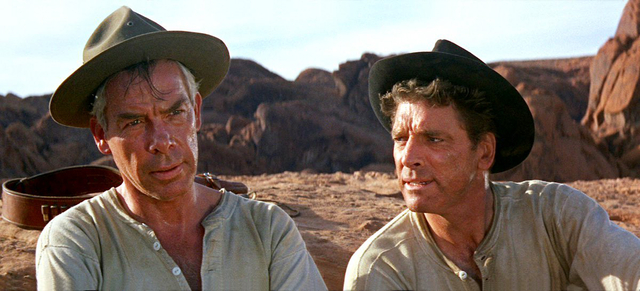
Lancaster's Dolworth is his foil – a ribald, lusty character with the most unmoored moral and ethical compass of all the men. He's allowed to define his own character when he describes himself as a creative soul, albeit one with no talent for words or music or painting. He creates by destroying – literally, with dynamite.
Robert Ryan was an actor with a talent for playing vicious heavies in films such as Crossfire, Odds Against Tomorrow (1959) and The Naked Spur (1953), but in The Professionals he's introduced punching out a cowboy for abusing a horse. His feeling for the lives and well-being of the animals in his charge makes him the closest thing to a moral centre in the group. Ehrengard is the only man who really suffers from the brutal heat of the desert; Ryan himself was in poor health at the time – he would succumb to cancer in 1973, just a year after his wife of over thirty years – but Brooks wanted him for the role so much that he obviously wrote his character's suffering into the part.
Woody Strode's Jake has the fewest lines of the group, but the skill of his character is what defines him – ultimately he's even more cool and competent than Marvin's Rico. In retrospect the film shortchanged its only black character, especially after he's introduced by Grant when the tycoon asks anyone has "any objections to working with a Negro" – a line aimed specifically at Rico, who counters it by coldly stating that money is more important to him than bigotry, and Jake's race is never an issue again.
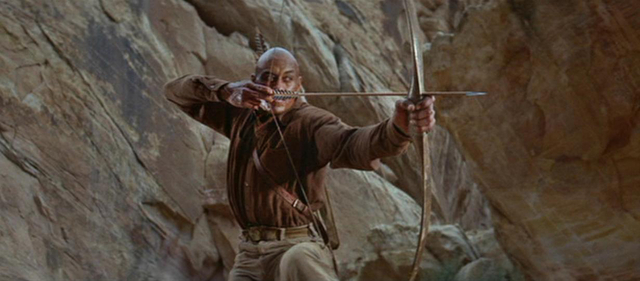
The men make their way to Raza's hacienda and coordinate a night attack, but discover literally at the moment it begins that Maria, far from being Raza's hostage, is actually his lover. They choose to go ahead with their plan anyway, and retreat back across the hills and desert with an unwilling Maria and Raza's men in pursuit – an extended action sequence that's regarded as a highlight of Brooks' picture.
Lord Jim might have been a flop, but there was nothing wrong with Brooks' handing of widescreen cinema. Working with ace cinematographer Conrad Hall, he fills the screen with incredible vistas – the film was mostly shot in Death Valley, Nevada's Valley of Fire and Coachella – and Hall's work with "day for night" scenes in the picture are among the best examples of making the sun stand in for the moon.
Brooks was a temperamental man with a reputation for irritability and even rage on set, but the actors who were alive to reminisce about the film twenty years ago remember him creating a great atmosphere while shooting, especially when they were being put up in Las Vegas. Strode and Martin ended up creating unexpected production costs when they decided it would be fun to shoot arrows at Vegas Vic, the famous smiling and waving cowboy neon sign outside Fremont Street's Pioneer Club.
As both writer and director, Brooks had the luxury of making sure as much of his terse, punchy dialogue as possible made it to the final cut. Characters define themselves with simple sentences and remarks – crucial in a film where most of the story is the journey to and from the big action sequences. Brief, two-line exchanges do most of the heavy lifting to define whole worldviews:
Dolworth: Well I'll be damned.
Rico: Most of us are.
Maria: Go to hell.
Dolworth: Yes ma'am. I'm on my way.
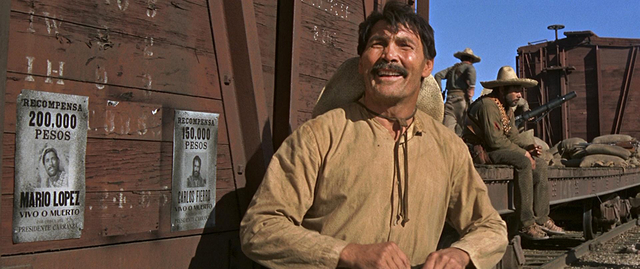
Palance's Raza is merely a shadowy villain – much respected as a former colleague by Dolworth and Rico – until the final gun battle, when Dolworth decides to stay behind to stall Raza and his men and give the rest of the team a chance to make for the border. By now their mission has lost its moral imperative, and has turned into a job, to be carried out for money and duty. This gives Dolworth and Raza, both wounded, a chance to discuss their history and motivation under the blazing sun, while angling for a chance to finish each other off.
They discuss the idealism that drove them to fight for Villa, and the gradual realization that their revolution – like all revolutions – became a lost cause once the politicians took over. They frame it in the language of a love affair, of passion and infatuation and disillusion, and Palance sums it all up by telling his old friend that "the Revolution is not a goddess but a whore." It's a political cynicism that might not have played well to the youth market at the time, but it obviously resonated with broader audiences, and it was a particular hit in France.
Gomez' Chiquita, up till then glimpsed mostly at a distance, shows why Rico and Dolworth held her in such high esteem as a soldier, and she gets a great death scene with Lancaster, who cradles her in his arms just moments after shooting her off her horse.
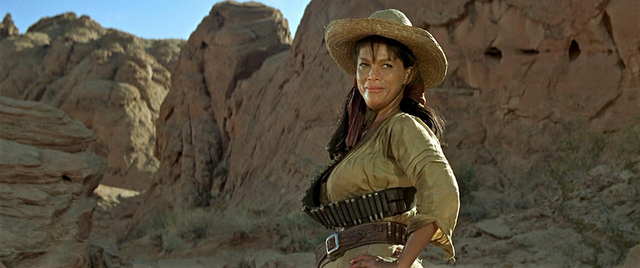
The film was a much-needed hit for Brooks, and he and Hall were both nominated for Academy Awards. Brooks went on to direct what's still probably the critical highlight of his career the next year – an adaptation of Truman Capote's true crime bestseller In Cold Blood. His last really notable picture was released a decade later with Looking for Mr. Goodbar, starring Diane Keaton as a schoolteacher leading a promiscuous double life in pickup bars – a controversial film that did a lot to sour the image of the '70s and the effects of the sexual revolution before that decade was over.
The Professionals still has a lot of fans, most of whom remember it as a film that walked the fine line between revisionist westerns, with their often-strident politics, sullen anti-heroes and aggressive myth-busting, and the heyday of the genre, when it delivered the most bang for the buck in terms of adventure and simple thrills. Typical reviews call it "a supremely entertaining western with good direction, a good cast, good characters and great action. It is also smart whilst actually not being that original and even now seems like a breath of fresh air within the western genre ... a must watch and for those who think old westerns were all the same ..."
In the meantime, we need only glimpse at Mexico's border regions – the setting for The Professionals – to see how a surplus of men trained for violence as criminals, law enforcement or paramilitaries can cause death and chaos and become a seemingly insurmountable obstacle to a society longing for the shopkeeper's peace. In movies as in real life, history often looks like a reboot.
Mark Steyn Club members can let Rick know what they think by logging in and sharing in the comments below, as access to the comments section is one of many benefits that comes along with membership in the Mark Steyn Club.


